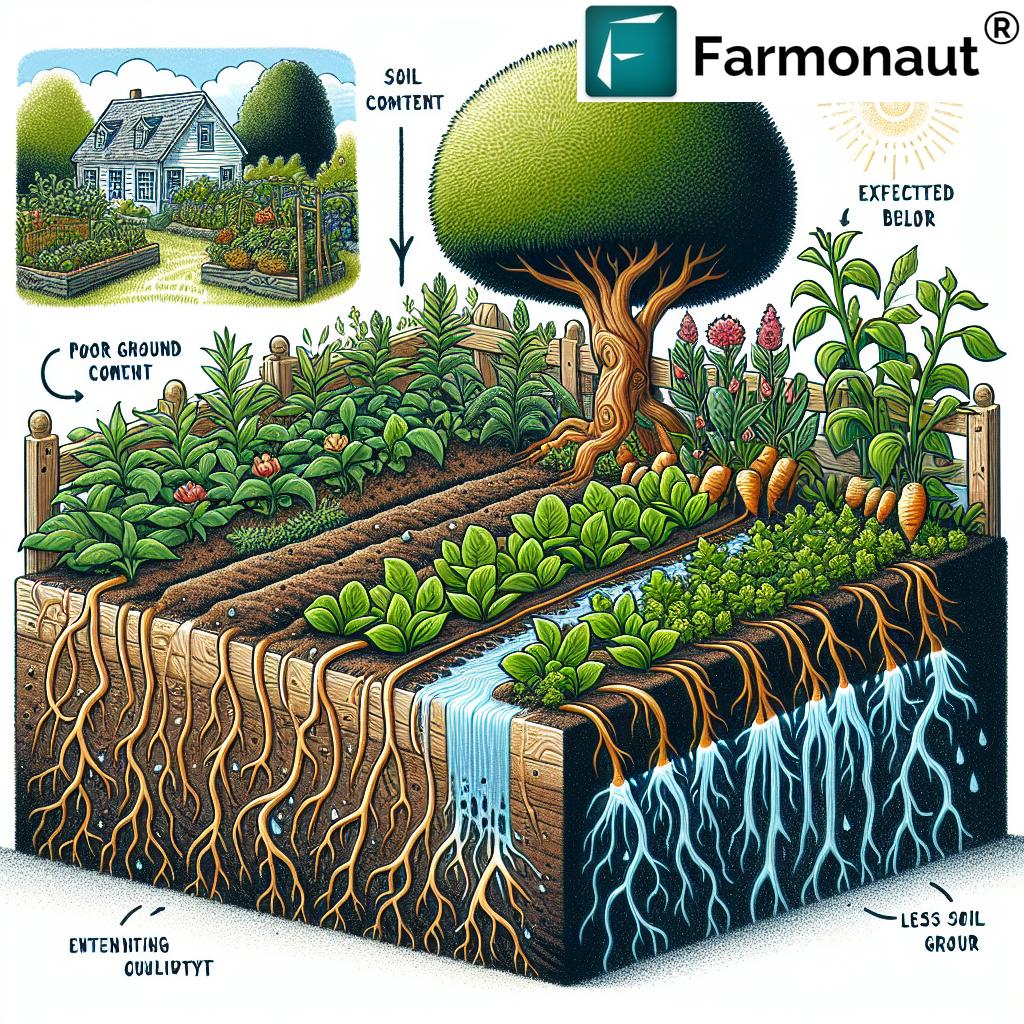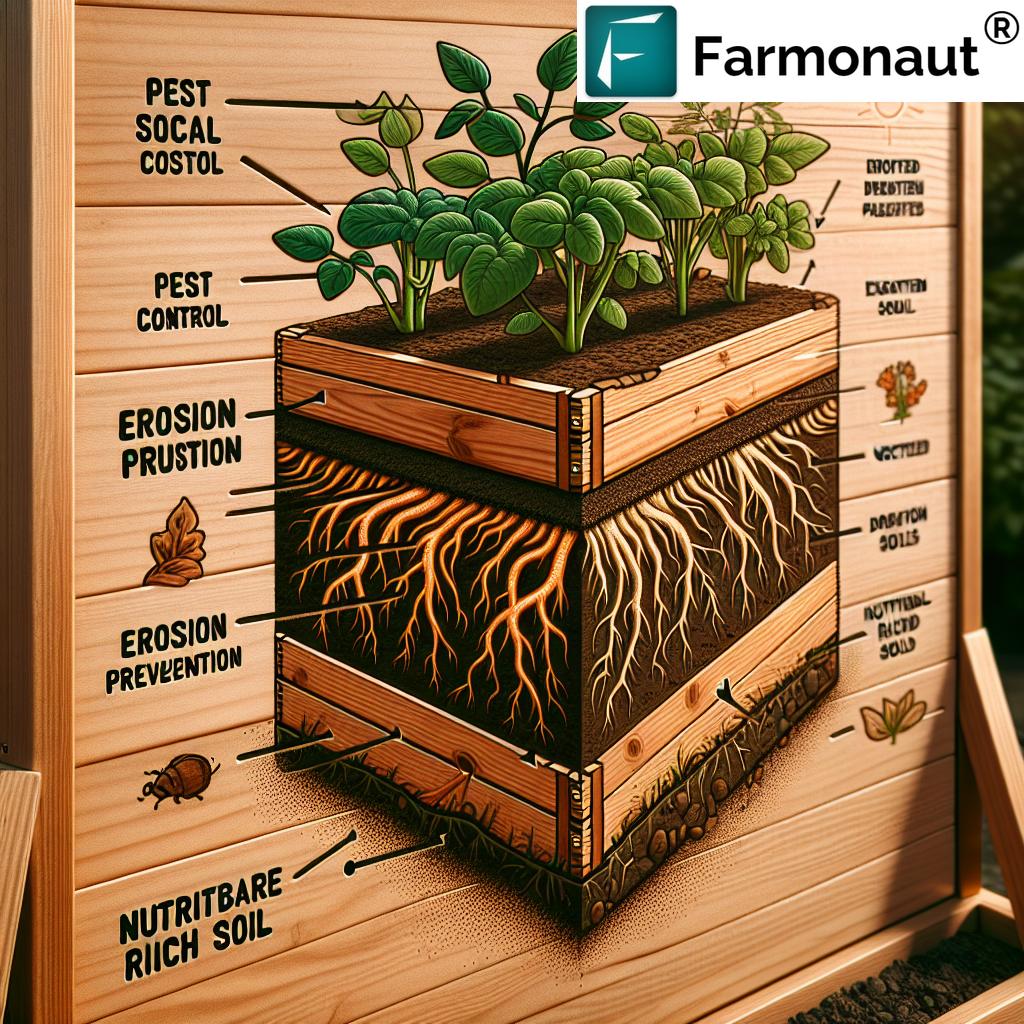Elevated Garden Beds: Boost Plant Health, Prevent Soil Erosion, and Improve Productivity

In the world of gardening and agriculture, we’re constantly seeking innovative ways to enhance our growing techniques and improve crop productivity. One method that has gained significant popularity in recent years is the use of elevated garden beds. These raised structures offer a multitude of benefits for both amateur gardeners and professional farmers alike. In this comprehensive guide, we’ll explore the advantages of elevated garden beds, their impact on soil health, plant growth, and overall garden management. We’ll also discuss how cutting-edge technology, such as Farmonaut’s satellite monitoring, can further enhance the benefits of these innovative gardening solutions.
Understanding Elevated Garden Beds
Elevated garden beds, also known as raised beds, are gardening structures that sit above ground level. They are typically filled with high-quality soil and designed to provide optimal growing conditions for a variety of plants. These beds can be constructed from various materials, including wood, concrete, metal, stone, or brick, each offering unique benefits in terms of durability, aesthetics, and functionality.
The Advantages of Elevated Garden Beds
Elevated garden beds offer numerous advantages over traditional in-ground gardening methods. Let’s explore some of the key benefits:
- Improved Soil Quality: By creating a contained environment, elevated beds allow for better control over soil composition and quality. This enables gardeners to create the ideal growing medium for their specific plants.
- Enhanced Drainage: The raised structure of these beds promotes excellent water drainage, reducing the risk of waterlogging and root rot.
- Erosion Prevention: Elevated beds help prevent soil erosion, especially in areas prone to heavy rainfall or wind.
- Pest Control: The height of elevated beds can deter some ground-dwelling pests, making it easier to manage and control pest infestations.
- Extended Growing Season: Soil in raised beds tends to warm up faster in spring, allowing for earlier planting and a longer growing season.
- Improved Accessibility: Elevated beds reduce the need for bending and kneeling, making gardening more accessible for people with mobility issues.
- Better Root Health: The loose, well-aerated soil in raised beds promotes healthy root development and growth.
- Increased Productivity: With optimal growing conditions, plants in elevated beds often yield higher harvests, improving overall garden productivity.
Soil Management in Elevated Garden Beds
One of the most significant advantages of elevated garden beds is the ability to control and manage soil quality effectively. Here’s how elevated beds contribute to better soil health:
- Custom Soil Blends: You can create the perfect soil mix tailored to your plants’ needs, incorporating organic matter, compost, and other amendments as necessary.
- Improved Soil Structure: The contained environment of raised beds prevents soil compaction, maintaining a loose, friable structure that’s ideal for root growth.
- Better Nutrient Retention: Well-managed soil in elevated beds can hold nutrients more effectively, reducing the need for frequent fertilization.
- pH Control: It’s easier to manage and adjust soil pH in a contained bed, allowing you to create the optimal growing environment for specific plants.
Water Management and Drainage
Proper water management is crucial for plant health, and elevated garden beds excel in this area:
- Enhanced Drainage: The raised structure allows excess water to drain freely, preventing waterlogged conditions that can lead to root problems.
- Efficient Irrigation: Elevated beds can be equipped with efficient irrigation systems, ensuring even water distribution and reducing water waste.
- Moisture Retention: While providing good drainage, properly designed raised beds can also retain adequate moisture for plant growth.
- Reduced Water Runoff: The contained nature of elevated beds helps prevent water runoff, keeping nutrients in the soil and reducing erosion.
Plant Health and Growth in Elevated Beds
Elevated garden beds create an ideal environment for plant health and vigorous growth:
- Root Development: The loose, well-aerated soil in raised beds allows for deep and extensive root systems, promoting stronger, healthier plants.
- Improved Oxygenation: Better soil structure ensures adequate oxygen supply to plant roots, essential for nutrient uptake and overall plant health.
- Disease Prevention: Good drainage and air circulation in elevated beds help prevent many soil-borne diseases.
- Optimal Growing Conditions: By controlling soil quality, moisture levels, and nutrient availability, elevated beds provide the perfect environment for plants to thrive.
Construction and Materials for Elevated Garden Beds
The choice of materials for constructing elevated garden beds can significantly impact their performance and longevity. Let’s explore some common options:
- Wood:
- Advantages: Natural look, easy to work with, relatively inexpensive
- Disadvantages: May rot over time, requires treatment for longevity
- Concrete:
- Advantages: Extremely durable, long-lasting, resistant to pests
- Disadvantages: Expensive, permanent, can be challenging to install
- Metal:
- Advantages: Durable, sleek appearance, resistant to pests and rot
- Disadvantages: Can heat up in direct sunlight, may rust over time
- Stone or Brick:
- Advantages: Attractive, long-lasting, excellent heat retention
- Disadvantages: Labor-intensive to construct, can be expensive
When choosing materials for your elevated garden beds, consider factors such as cost, durability, aesthetics, and the specific needs of your plants.
Managing Pests and Diseases in Elevated Garden Beds
While elevated garden beds can help reduce pest and disease issues, they’re not entirely immune. Here are some strategies for effective pest and disease management:
- Crop Rotation: Regularly rotate crops to prevent the buildup of pests and diseases specific to certain plant families.
- Companion Planting: Utilize companion planting techniques to naturally deter pests and promote beneficial insect populations.
- Regular Monitoring: Inspect your plants frequently for signs of pest infestations or disease symptoms.
- Proper Spacing: Ensure adequate spacing between plants to promote good air circulation, reducing the risk of fungal diseases.
- Organic Pest Control: Use organic pest control methods when necessary, such as neem oil or insecticidal soaps.
Enhancing Elevated Garden Beds with Technology: The Farmonaut Advantage
While elevated garden beds offer numerous benefits on their own, integrating advanced technology can take your gardening efforts to the next level. This is where Farmonaut’s innovative satellite monitoring system comes into play.
Farmonaut is a pioneering agricultural technology company that provides advanced, satellite-based farm management solutions. By leveraging Farmonaut’s technology, gardeners and farmers can further enhance the benefits of elevated garden beds through precise monitoring and data-driven insights.
How Farmonaut’s Satellite Monitoring Enhances Elevated Garden Beds
- Real-time Crop Health Monitoring: Farmonaut’s satellite imagery provides up-to-date information on vegetation health, allowing you to quickly identify and address any issues in your elevated garden beds.
- Soil Moisture Analysis: Satellite data can help you optimize your watering schedule by providing accurate soil moisture information, reducing the risk of over or under-watering.
- Early Pest and Disease Detection: Advanced imaging techniques can help identify potential pest infestations or disease outbreaks before they become visible to the naked eye, allowing for early intervention.
- Nutrient Management: Satellite data can provide insights into nutrient levels in your elevated beds, helping you make informed decisions about fertilization and soil amendments.
- Growth Tracking: Monitor plant growth rates and overall crop development, allowing you to optimize your gardening practices for maximum yield.
To learn more about how Farmonaut can enhance your elevated garden bed experience, visit Farmonaut’s App or explore their API documentation.
Comparing Traditional Garden Beds vs. Elevated Garden Beds with Farmonaut Satellite Monitoring
| Aspect | Traditional Garden Beds | Elevated Garden Beds with Farmonaut Monitoring |
|---|---|---|
| Soil Health | Variable, dependent on existing soil conditions | Optimized soil composition with real-time monitoring of soil health indicators |
| Plant Productivity | Moderate, influenced by existing soil and environmental factors | High, due to optimized growing conditions and data-driven management |
| Pest Detection | Manual observation, often reactive | Early detection through satellite imaging, allowing proactive management |
| Water Management | Often inefficient, based on general guidelines | Precise, based on real-time soil moisture data from satellite monitoring |
| Overall Crop Yield | Variable, dependent on numerous factors | Consistently higher due to optimized conditions and data-driven decision making |
Best Practices for Maintaining Elevated Garden Beds
To ensure the longevity and productivity of your elevated garden beds, follow these best practices:
- Regular Soil Testing: Conduct soil tests annually to monitor nutrient levels and pH, adjusting as necessary.
- Crop Rotation: Implement a crop rotation plan to maintain soil health and prevent pest and disease buildup.
- Mulching: Apply organic mulch to conserve moisture, suppress weeds, and add nutrients to the soil as it decomposes.
- Composting: Incorporate homemade or high-quality compost regularly to maintain soil fertility and structure.
- Proper Watering: Water deeply but less frequently to encourage deep root growth and drought resistance.
- Structural Maintenance: Regularly inspect and repair the bed structure to prevent soil loss and maintain aesthetics.
Overcoming Challenges in Elevated Garden Beds
While elevated garden beds offer many advantages, they can also present some challenges. Here’s how to address common issues:
- Soil Drying: Elevated beds can dry out faster than in-ground gardens. Use mulch and consider installing a drip irrigation system to maintain consistent moisture levels.
- Limited Space: Maximize vertical space by incorporating trellises or using companion planting techniques to grow more in a limited area.
- Nutrient Depletion: Regular addition of compost and organic fertilizers can help maintain soil fertility in the contained environment of raised beds.
- Temperature Fluctuations: Use season extenders like row covers or cold frames to protect plants from extreme temperatures in elevated beds.
Incorporating Elevated Garden Beds in Various Settings
Elevated garden beds are versatile and can be incorporated into various settings:
- Urban Gardens: Perfect for small spaces, balconies, or rooftop gardens in urban environments.
- Community Gardens: Ideal for shared gardening spaces, providing clear boundaries and personalized growing areas.
- School Gardens: Excellent for educational purposes, allowing students to learn about plant growth and garden management.
- Commercial Farms: Can be used for specialized crops or as part of a larger agricultural operation to maximize productivity.
The Future of Elevated Garden Beds with Smart Technology
As technology continues to advance, the integration of smart systems with elevated garden beds is becoming increasingly common. Here are some exciting developments:
- Automated Irrigation Systems: Smart watering systems that adjust based on soil moisture levels and weather forecasts.
- Climate Control: For greenhouse-style raised beds, automated systems can manage temperature, humidity, and ventilation.
- AI-Powered Plant Care: Advanced systems that use artificial intelligence to provide personalized care recommendations for each plant.
- Remote Monitoring: Apps and sensors that allow gardeners to monitor their elevated beds from anywhere, providing real-time data on plant health and environmental conditions.
Farmonaut’s satellite monitoring technology is at the forefront of these advancements, offering unprecedented insights into crop health and environmental conditions. To explore how Farmonaut can revolutionize your gardening experience, download the app for Android or iOS.
Environmental Benefits of Elevated Garden Beds
Elevated garden beds not only benefit the gardener but also contribute to environmental sustainability:
- Water Conservation: Efficient watering and reduced runoff help conserve water resources.
- Soil Conservation: By preventing erosion and maintaining soil health, raised beds contribute to long-term soil conservation efforts.
- Biodiversity: Well-managed raised beds can support a diverse ecosystem of beneficial insects and microorganisms.
- Carbon Sequestration: Healthy soil in raised beds can act as a carbon sink, helping to mitigate climate change on a small scale.
Economic Considerations of Elevated Garden Beds
While the initial cost of setting up elevated garden beds may be higher than traditional in-ground gardening, they offer several economic benefits:
- Increased Yield: Higher productivity can lead to greater harvests and potential cost savings on produce.
- Reduced Input Costs: Better pest and disease management can reduce the need for pesticides and other treatments.
- Water Savings: Efficient water use can lead to lower water bills, especially in drought-prone areas.
- Long-term Value: Well-constructed raised beds can last for many years, providing a good return on investment.
Case Studies: Success with Elevated Garden Beds
While we don’t include specific case studies, it’s worth noting that numerous gardeners, from hobbyists to commercial growers, have reported significant success with elevated garden beds. Common themes in these success stories include:
- Substantial increases in crop yields
- Improved management of challenging soil conditions
- Enhanced ability to grow a wider variety of plants
- Greater engagement with gardening due to increased accessibility
FAQs About Elevated Garden Beds
Q: How deep should an elevated garden bed be?
A: The ideal depth depends on the plants you’re growing. For most vegetables, a depth of 6-12 inches is sufficient. Deep-rooted plants may require beds up to 18 inches deep.
Q: Can I use elevated garden beds in areas with poor soil?
A: Absolutely! Elevated beds are an excellent solution for areas with poor or contaminated soil, as you can fill them with high-quality growing medium.
Q: How often should I replace the soil in my elevated garden bed?
A: With proper management, you shouldn’t need to replace the soil entirely. Instead, add compost and organic matter annually to replenish nutrients and maintain soil structure.
Q: Are elevated garden beds suitable for all types of plants?
A: While elevated beds are suitable for most plants, very large or deep-rooted plants (like some fruit trees) may be better suited to in-ground planting.
Q: How can I prevent my elevated garden bed from drying out too quickly?
A: Use mulch to retain moisture, consider installing a drip irrigation system, and monitor soil moisture regularly. Farmonaut’s satellite monitoring can provide valuable insights into soil moisture levels.
Conclusion
Elevated garden beds offer a multitude of benefits for gardeners and farmers alike. From improved soil health and better drainage to enhanced pest control and increased productivity, these innovative structures can revolutionize your growing experience. By combining the advantages of elevated beds with cutting-edge technology like Farmonaut’s satellite monitoring system, gardeners can take their efforts to new heights, achieving unprecedented levels of productivity and sustainability.
As we continue to face challenges in agriculture and food production, solutions like elevated garden beds and advanced monitoring technologies will play an increasingly important role in ensuring food security and promoting sustainable gardening practices. Whether you’re a hobbyist gardener or a professional farmer, consider incorporating elevated garden beds into your growing strategy and explore how Farmonaut’s technology can help you maximize your garden’s potential.
Ready to take your gardening to the next level? Subscribe to Farmonaut’s services and experience the future of precision agriculture:
For more information on Farmonaut’s satellite monitoring technology and API integration, visit our developer documentation.














